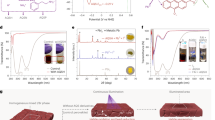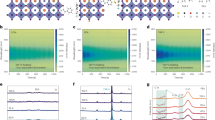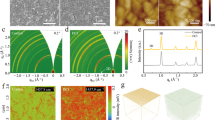Abstract
Despite improvements in the power conversion efficiency (PCE) of perovskite solar cells (PSCs), stability issues due to ion migration and phase separation remain critical concerns. Given the ionic crystal nature of perovskites, the use of multivalent cations is supposed to effectively suppress ionic migration. However, multivalent metal cations produce deep-level trap states, thus impairing device efficiency. Therefore, a multivalent cation replacement strategy that minimizes interstitial defects is desirable. Here we develop a divalent cation replacement strategy that mitigates ionic migration while limiting phase segregation. We demonstrate that the replacement of the A-site cations in the perovskite lattice with methylenediammonium cations (MDA2+) substantially suppresses the above issues in wide-bandgap perovskites. This is mainly due to the bivalent state of MDA2+ generating a strong interaction with the inorganic framework and reducing the mobility of halide ions and the formation of defects. As a result, the stability and efficiency of the fabricated PSCs are substantially improved. We demonstrate a champion PCE of 23.20% (certified 22.71%) for a single-junction PSC with a bandgap between 1.67 eV and 1.68 eV. Furthermore, a PCE of 30.13% is obtained for mechanically stacked perovskite/Cu(In,Ga)Se2 tandem devices, and a PCE of 21.88% for translucent perovskite devices. Finally, we obtain a steady-state PCE of 23.28% (certified 22.79%) for flexible monolithic perovskite/Cu(In,Ga)Se2 tandem cells.
This is a preview of subscription content, access via your institution
Access options
Access Nature and 54 other Nature Portfolio journals
Get Nature+, our best-value online-access subscription
$32.99 / 30 days
cancel any time
Subscribe to this journal
Receive 12 print issues and online access
$259.00 per year
only $21.58 per issue
Buy this article
- Purchase on SpringerLink
- Instant access to full article PDF
Prices may be subject to local taxes which are calculated during checkout




Similar content being viewed by others
Data availability
All data are available in the Article or its Supplementary Information. Additional information can be obtained from the corresponding authors upon reasonable request.
References
Manser, J. S., Christians, J. A. & Kamat, P. V. Intriguing optoelectronic properties of metal halide perovskites. Chem. Rev. 116, 12956–13008 (2016).
Jiang, Q. & Zhu, K. Rapid advances enabling high-performance inverted perovskite solar cells. Nat. Rev. Mater. 9, 399–419 (2024).
Zhao, K. et al. peri-Fused polyaromatic molecular contacts for perovskite solar cells. Nature 632, 301–306 (2024).
Li, S. et al. High-efficiency and thermally stable FACsPbI3 perovskite photovoltaics. Nature 635, 82–88 (2024).
Chen, H. et al. Improved charge extraction in inverted perovskite solar cells with dual-site-binding ligands. Science 384, 189–193 (2024).
Aydin, E. et al. Pathways toward commercial perovskite/silicon tandem photovoltaics. Science 383, 162 (2024).
Wang, R. et al. Prospects for metal halide perovskite-based tandem solar cells. Nat. Photonics 15, 411–425 (2021).
Lin, R. et al. All-perovskite tandem solar cells with 3D/3D bilayer perovskite heterojunction. Nature 620, 994–1000 (2023).
Aydin, E. et al. Enhanced optoelectronic coupling for perovskite/silicon tandem solar cells. Nature 623, 732–738 (2023).
Al-Ashouri, A. et al. Monolithic perovskite/silicon tandem solar cell with >29% efficiency by enhanced hole extraction. Science 370, 1300–1309 (2020).
Tian, L., Xue, J. & Wang, R. Halide segregation in mixed halide perovskites: visualization and mechanisms. Electronics 11, 700 (2022).
Wang, Z. et al. Suppressed phase segregation for triple-junction perovskite solar cells. Nature 618, 74–79 (2023).
Azmi, R. et al. Double-side 2D/3D heterojunctions for inverted perovskite solar cells. Nature 628, 93–98 (2024).
Wen, J. et al. Heterojunction formed via 3D-to-2D perovskite conversion for photostable wide-bandgap perovskite solar cells. Nat. Commun. 14, 7118 (2023).
Luo, L. et al. Stabilization of 3D/2D perovskite heterostructures via inhibition of ion diffusion by cross-linked polymers for solar cells with improved performance. Nat. Energy 8, 294–303 (2023).
Yang, S. et al. Stabilizing halide perovskite surfaces for solar cell operation with wide-bandgap lead oxysalts. Science 365, 473–478 (2019).
Bai, S. et al. Planar perovskite solar cells with long-term stability using ionic liquid additives. Nature 571, 245–250 (2019).
Xu, J. et al. Triple-halide wide-band gap perovskites with suppressed phase segregation for efficient tandems. Science 367, 1097–1104 (2020).
Liu, S. et al. Triple-junction solar cells with cyanate in ultrawide-bandgap perovskites. Nature 628, 306–312 (2024).
Zhang, Z. et al. Suppression of phase segregation in wide-bandgap perovskites with thiocyanate ions for perovskite/organic tandems with 25.06% efficiency. Nat. Energy 9, 592–601 (2024).
Zhao, Y. et al. Suppressing ion migration in metal halide perovskite via interstitial doping with a trace amount of multivalent cations. Nat. Mater. 21, 1396–1402 (2022).
Min, H. et al. Efficient, stable solar cells by using inherent bandgap of alpha-phase formamidinium lead iodide. Science 366, 749–753 (2019).
Kim, G. et al. Impact of strain relaxation on performance of alpha-formamidinium lead iodide perovskite solar cells. Science 370, 108–112 (2020).
Duijnstee, E. A. et al. Understanding the degradation of methylenediammonium and its role in phase-stabilizing formamidinium lead triiodide. J. Am. Chem. Soc. 145, 10275–10284 (2023).
Ugur, E. et al. Enhanced cation interaction in perovskites for efficient tandem solar cells with silicon. Science 385, 533–538 (2024).
Zhao, Y. et al. Inactive (PbI2)2RbCl stabilizes perovskite films for efficient solar cells. Science 377, 531–534 (2022).
Zhao, X. et al. Accelerated aging of all-inorganic, interface-stabilized perovskite solar cells. Science 377, 307–310 (2022).
Yin, W.-J., Shi, T. & Yan, Y. Unusual defect physics in CH3NH3PbI3 perovskite solar cell absorber. Appl. Phys. Lett. 104, 063903 (2014).
Eames, C. et al. Ionic transport in hybrid lead iodide perovskite solar cells. Nat. Commun. 6, 7497 (2015).
Liang, H. et al. 29.9%-efficient, commercially viable perovskite/CuInSe2 thin-film tandem solar cells. Joule 7, 2859–2872 (2023).
Liu, X. et al. Over 28% efficiency perovskite/Cu(InGa)Se2 tandem solar cells: highly efficient sub-cells and their bandgap matching. Energy Environ. Sci. 16, 5029–5042 (2023).
Zheng, J. et al. Efficient flexible monolithic perovskite–CIGS tandem solar cell on conductive steel substrate. ACS Energy Lett. 9, 1545–1547 (2024).
Jeong, I. et al. Flexible and lightweight perovskite/Cu(In,Ga)Se2 tandem solar cells. Joule https://doi.org/10.1016/j.joule.2024.11.011 (2024).
Acknowledgements
R.W. acknowleges the grant from the National Natural Science Foundation of China (grant number 62474143). R.W. and J. Xue acknowledge the grants (grant numbers LDG25E020001, LD22E020002 and LD24E020001) from the Natural Science Foundation of Zhejiang Province of China. J. Xue acknowledges the grants from the Natural Science Foundation of Zhejiang Province of China (grant number LR24F040001) and the National Natural Science Foundation of China (grant number 62274146) as well as the financial support from Shanxi-Zheda Institute of Advanced Materials and Chemical Engineering (2021SZ-FR006). R.W. acknowleges the support of Key R&D Program of Zhejiang (2024SSYS0061). E.B. acknowledges the grant from the Major Industrial Innovation Project of Anhui Province (grant number AHZDCYCX-LSDT2023-10). Computing resources used in this work were provided by the National Center for High Performance Computing of Turkey (UHeM) under the grant number 1015902023. We are grateful to Y. Chen from Instrumentation and Service Center for Physical Sciences, Westlake University, for help with the measurement and analysis of ToF-SIMS data.
Author information
Authors and Affiliations
Contributions
R.W. and J. Xue directed and supervised the project. L.T., R.W. and E.B. conceived the idea and designed the experiment. L.T. fabricated and characterized perovskite films and devices. I.Y. and C.D. conducted the DFT calculations and data analysis. Y.T. and Q.L. performed UPS measurements. Y.T. conducted the tDOS test. S.Z. and J.S. carried out FTIR measurements. Z.C. assisted in the PL imaging test. L.X. contributed to FLIM characterization. Z.Y. assisted in temperature-dependent conductivity measurements. J.Z., L.Y., K.Z., J. Xu, P.S., X.Z., S.W. and S.C. helped with the characterizations and device fabrication. E.B. and M.H. provided CIGS cells. L.T. wrote the paper. R.W., J. Xue, L.T. and E.B. reviewed and edited the paper. All authors discussed the results and commented on the paper.
Corresponding authors
Ethics declarations
Competing interests
R.W., L.T., J. Xue, E.B. and M.H. are inventors on a patent application related to this work filed by Westlake University and Advanced Photovoltaic Technology Research Institute of Xuancheng. The other authors declare no competing interests.
Peer review
Peer review information
Nature Photonics thanks Sang Il Seok and the other, anonymous, reviewer(s) for their contribution to the peer review of this work.
Additional information
Publisher’s note Springer Nature remains neutral with regard to jurisdictional claims in published maps and institutional affiliations.
Supplementary information
Supplementary Information
Supplementary Texts 1–7, Figs. 1–49 and Tables 1–8.
Rights and permissions
Springer Nature or its licensor (e.g. a society or other partner) holds exclusive rights to this article under a publishing agreement with the author(s) or other rightsholder(s); author self-archiving of the accepted manuscript version of this article is solely governed by the terms of such publishing agreement and applicable law.
About this article
Cite this article
Tian, L., Bi, E., Yavuz, I. et al. Divalent cation replacement strategy stabilizes wide-bandgap perovskite for Cu(In,Ga)Se2 tandem solar cells. Nat. Photon. 19, 479–485 (2025). https://doi.org/10.1038/s41566-025-01618-z
Received:
Accepted:
Published:
Issue date:
DOI: https://doi.org/10.1038/s41566-025-01618-z
This article is cited by
-
Non-volatile solid-state 4-(N-carbazolyl)pyridine additive for perovskite solar cells with improved thermal and operational stability
Nature Energy (2025)
-
Antisolvent seeding of self-assembled monolayers for flexible monolithic perovskite/Cu(In,Ga)Se2 tandem solar cells
Nature Energy (2025)
-
Light in heart, forge ahead—Professor Rui Wang’s adventures in perovskite solar cell frontiers
Light: Science & Applications (2025)



